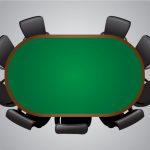In my first strategy post on forming ranges, I mostly touched on preflop. But postflop, as we all know, is where the big money is at. And it’s postflop where forming ranges is the most important, it’s just a whole lot harder!
The basic premise of forming ranges is very simple. You group a hand in a range where it maximizes that hands profit and the other hands in its ranges profit. Notice the latter point. Our hand has value in a range not only by itself, but it also affects the total EV of the range. If this still isn’t clear, it’s obvious if you reraise AA only preflop, you won’t get any action (assuming somewhat attentive opponents), but adding 65s to your preflop reraising range will add a lot more profit to your AA than the profit of 65s. Now, since most ranges consist of several hands, you can imagine how much more profit you can gain from just adding a few bluffs or draws to your range!
I’d like to digress just a bit. One thing I always say is that making a marginal call is infinitely worse than making a semi bad bluff. The idea of ranges should explain this to you. Having a bad hand in your range after checking barely affects the range of hands your opponent will bet with, but having a bad hand in your range when your betting affects the profitability of all the hands in your range. For more on this, check this post. It will blow your mind!
Now that we know why thinking about forming our range is important, we need to think about how to do it. A lot of the time when people start incorporating aggression in their game, they discover that their opponents range is weak in certain spots and they start raising like crazy when they see it. Now that’s not necessarily bad, but you have to think of your game beyond a singular hand.
Think about this situation. We have a Tagg opponent raising from the CO, and we call on the BU with 89dd. The flop comes Ks5c2h. Our opponent comes out betting. We know his range is weak here (however as is ours), so we correctly should be raising a wide range of hands. But raising 98dd here is a mistake. Why? Because if we were to raise 98dd here, we’d be raising with 100% of the hands we would cold call, and we likely do not want to do that. Our opponent could catch on easily or make a spastic bluff, and we’re completely exploitable by a solid player.
What people don’t get is when you decide you are going to raise the flop light, it shouldn’t be random and based on timing and game flow. Generally, you should have an idea of exactly the hands you are going to raise here, and these hands are simply the best hands in our range versus our opponents range. So if we decide to raise this flop 30% of the time, which is reasonable, we’d raise some of the better 30% of our hands in our range.
KQ,KJ,KT,55, 22 are pretty obvious. But how about our bluffs? A3,A4,34,64, Axcc, Axss, Axhh would be a definite bluff hands here for me. Why? Simply because they are going to have the best equity against our opponents calling range. If he calls the flop with KJ/KQ I can spike an Ace with the Axs, I can spike a gutshot with the draws, and a straight with 43. Now most opponents aren’t going to call very light on this flop, but when you feel the adjustment coming, you could very well add 99-77 to this range. As his calling range changes, so does our raising range.
Of course hands like 5x, 2x, or low pocket pairs may be solid hands against his range. But do we want to raise them? A hand like 2x is so likely to get sucked out on we may very well want to raise it, and turn our hand into a two pair draw. A weak 5x also may be a solid raising hand for the same reason. This board is also such a good two barrel board for our opponent, our hand may just become worthless fold equity for our opponent. However, a lot of the time we are going to want to call with our midpair, as they have solid show down value and don’t need to be turned into bluffs.
Okay, reality check:
1. Every hand in your range is affected by every other hand in your range. Even if you lose money with one hand, it may be so good for your entire range that it becomes a very +EV play. Since there is no bluffing when you check/call, and checking weak hands doesn’t affect your opponents betting range very much, making a bad bluff is infinitely better than making a bad call.
2. When choosing a raising, betting, or calling range, don’t be arbitrary. If you choose to raise 20% of your hands, than raise some of the better 20% against your opponents range.
3. Sometimes hands are better off calling, and sometimes it is better to turn them into two pair/ trip draws.
Hope this week helps!
Submit your review | |









